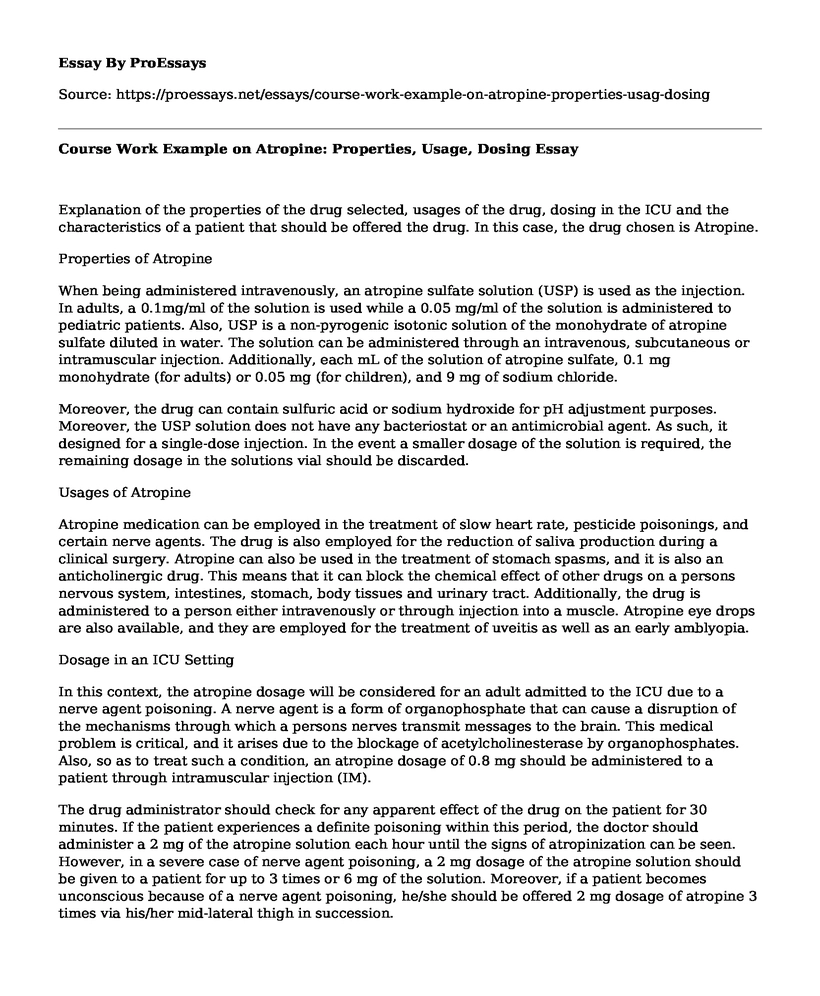Explanation of the properties of the drug selected, usages of the drug, dosing in the ICU and the characteristics of a patient that should be offered the drug. In this case, the drug chosen is Atropine.
Properties of Atropine
When being administered intravenously, an atropine sulfate solution (USP) is used as the injection. In adults, a 0.1mg/ml of the solution is used while a 0.05 mg/ml of the solution is administered to pediatric patients. Also, USP is a non-pyrogenic isotonic solution of the monohydrate of atropine sulfate diluted in water. The solution can be administered through an intravenous, subcutaneous or intramuscular injection. Additionally, each mL of the solution of atropine sulfate, 0.1 mg monohydrate (for adults) or 0.05 mg (for children), and 9 mg of sodium chloride.
Moreover, the drug can contain sulfuric acid or sodium hydroxide for pH adjustment purposes. Moreover, the USP solution does not have any bacteriostat or an antimicrobial agent. As such, it designed for a single-dose injection. In the event a smaller dosage of the solution is required, the remaining dosage in the solutions vial should be discarded.
Usages of Atropine
Atropine medication can be employed in the treatment of slow heart rate, pesticide poisonings, and certain nerve agents. The drug is also employed for the reduction of saliva production during a clinical surgery. Atropine can also be used in the treatment of stomach spasms, and it is also an anticholinergic drug. This means that it can block the chemical effect of other drugs on a persons nervous system, intestines, stomach, body tissues and urinary tract. Additionally, the drug is administered to a person either intravenously or through injection into a muscle. Atropine eye drops are also available, and they are employed for the treatment of uveitis as well as an early amblyopia.
Dosage in an ICU Setting
In this context, the atropine dosage will be considered for an adult admitted to the ICU due to a nerve agent poisoning. A nerve agent is a form of organophosphate that can cause a disruption of the mechanisms through which a persons nerves transmit messages to the brain. This medical problem is critical, and it arises due to the blockage of acetylcholinesterase by organophosphates. Also, so as to treat such a condition, an atropine dosage of 0.8 mg should be administered to a patient through intramuscular injection (IM).
The drug administrator should check for any apparent effect of the drug on the patient for 30 minutes. If the patient experiences a definite poisoning within this period, the doctor should administer a 2 mg of the atropine solution each hour until the signs of atropinization can be seen. However, in a severe case of nerve agent poisoning, a 2 mg dosage of the atropine solution should be given to a patient for up to 3 times or 6 mg of the solution. Moreover, if a patient becomes unconscious because of a nerve agent poisoning, he/she should be offered 2 mg dosage of atropine 3 times via his/her mid-lateral thigh in succession.
Description of a Patient Who Should Be Offered Atropine
The atropine drug should be given to a patient suffering from any form of nerve agent poisoning. In addition, such a patient may portray symptoms such as them contraction of the pupils, convulsions, involuntary defecation or urination and profuse salivation. Nevertheless, Atropine dosage can also be issued to adults in the treatment of Bradyarrhythmia, Rhinorrhea, AV heart block, head injury, anesthesia and peptic ulcers. Moreover, in the pediatric acute treatment, the drug can be offered to children suffering from the same medical conditions.
Cite this page
Course Work Example on Atropine: Properties, Usage, Dosing. (2021, Jun 25). Retrieved from https://proessays.net/essays/course-work-example-on-atropine-properties-usag-dosing
If you are the original author of this essay and no longer wish to have it published on the ProEssays website, please click below to request its removal:
- Objection to Medical Assistance in Dying Essay
- Essay Sample on Growing Concern of Alzheimer's Disease in UK
- Essay Example on Financial Future of Medicare
- Providing Palliative Care at End-of-Life: Assessing Total Pain & Effective Communication - Essay Sample
- Essay Sample on Elderly Pain Management: Essential for Quality Life
- Essay Example on Unraveling the Role of BRCA1 & BRCA2 in Breast Cancer
- Disease Model of Addiction - Free Essay Example







